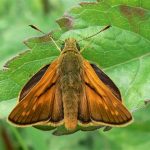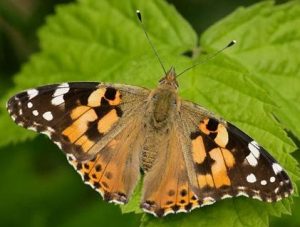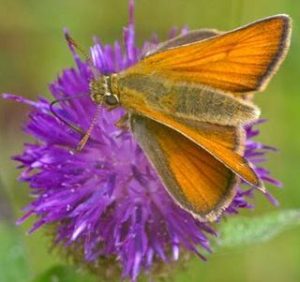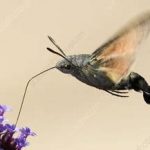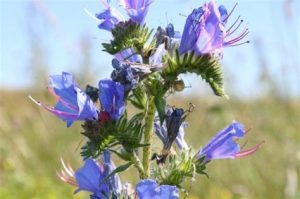VIPER’S BUGLOSS (Echium vulgare)
Europe, Asia
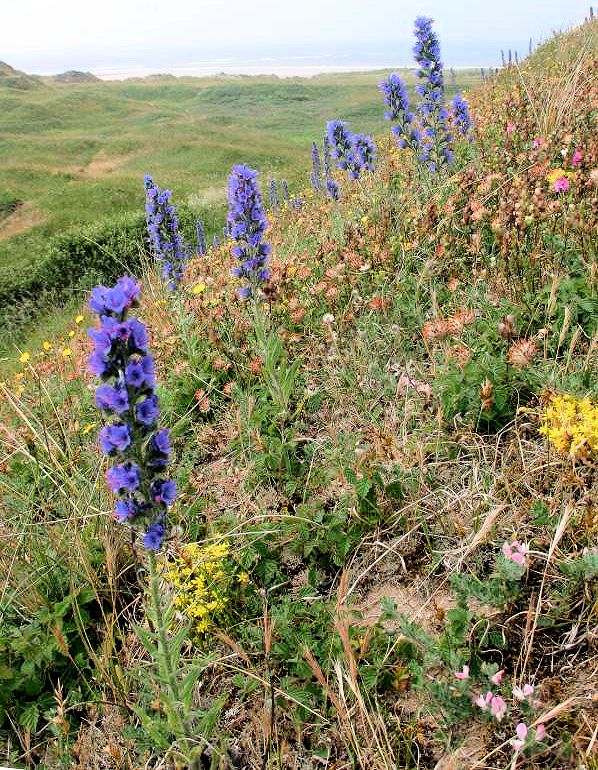
Viper’s Bugloss in Kenfig National Natural Reserve, S Wales Photo from FIRST NATURE, a not-for-profit volunteer-run online resource
Echium vulgare is a beautiful wildlower, usually biennial, which puts out a basal rosette of lance-shaped hairy leaves, 2 to 6 inches long at the base, in its first year.
In year two, spotted hairy stems rise from the leaves on the ground, ending in spires of VIVID BLUE flowers with red stamens & blue pollen. The flowers open from base to tip, blooming from May to September. The plant itself may grow to 3 feet.
Viper’s Bugloss is drought tolerant and disease free. It likes dry, gritty free-draining soil & does well in gravel gardens. Its long tap root finds water deep down when plants all around have gone crisp in drought.
In the wild this perennial can be found growing on hillsides, sand dunes & rocky places near water.
Jeremy Bartlett’s LET IT GROW blog… https://www.jeremybartlett.co.uk/2018/07/11/vipers-bugloss-echium-vulgare/
Preferred Sites, Losses
‘Native to the Mediterranean region, where it grows on open sunny hillsides, dry grassland & chalky soil. It also grows on calcareous soils of Northern France, Belgium, the Netherlands and Germany. Naturalized in Northern Ireland and parts of North America.’ Glenlivet Wildlife, https://glenlivet-wildlife.co.uk/
“Since 1930 E. Vulgare has declined somewhat in frequency, due to agricultural intensification, reclamation and the development of neglected ground.” Online Atlas of the British & Irish Flora – https://plantatlas.brc.ac.uk/plant/echium-vulgare
Vipers Bugloss, Orford, Suffolk, filmed by Aaron Kitching, Youtube
Bees Favourite
Viper’s Bugloss is nectar-rich for honeybees & other pollinating insects.
This is one of the best plants for nectar. It is attractive to bees, hoverflies & butterflies such as The Painted Lady, Large Skipper & Small Skipper & the Humming-bird Hawkmoth.
It is also one of the food plants of the Painted Lady Butterfly, along with thistle, nettle and mallows. The Wildflower Nursery, https://www.thewildflowernursery.co.uk/product-page/viper-s-bugloss
Echium vulgare provides food for a range of insects including the Buff-tailed and Red-tailed bumblebees, Large Skipper and Painted Lady Butterflies, Honeybees and Red Mason Bees. The Wildlife Trusts
Historical
In ancient history,
“Helen of Troy offered Echium Vulgare to her guests during a dinner gathering. At the time, the plant was used to lift the spirits and relieve headaches and nervous energy.” Homer
Negatives
Handling it without gloves causes dermatitis and all parts can cause stomach upsets if taken internally (what about Helen of Troy’s dinner guests? deliberate?)
This plant grows & spreads aggressively, so it is not recommended for containers or hanging baskets.’ (If only I’d read this before attempting to grow it in a container.)
Many gardeners grow it in wild or informal gardens. Best seen growing wild in meadows & dunes, on cliffs & on roadsides. Brandy Wells, Petal Republic, Utimate Guide to Viper’s Bugloss, https://www.petalrepublic.com/vipers-bugloss/
In Floriography, the Victorian Language of Flowers, bugloss was given the quality of ‘falsehood’,
Medicinal
Medicinally it helps provoke a sweat and has diuretic properties too, thus helping the body expel toxins. Like comfrey it contains allantoin which makes it useful for healing injuries by promoting growth of new cells. It has also been used as a poultice for healing boils. Like borage it was said to dispel melancholy and being demulcent it was used particularly in chest complaints with dry coughs. Hilda Leyel considered it a cordial herb similar to borage and writes that it is “very useful in feverish colds and chest complaints; and cooling and cheering and decorative in wine cups and summer drinks.”
Above all however Viper’s Bugloss, as its name suggests, has been considered one of the main local remedies for snake bites. I learnt recently from Surrey based herbalist and member of the Herbarium, Stephen Church, that the tincture can be used both externally and internally for any number of insect bites as well.”
Viper’s Bugloss – A Most Singular Remedy Against Poyson’ / Whispering Earth, https://whisperingearth.co.uk/2011/07/10/vipers-bugloss-a-most-singular-remedy-against-poyson/
How it got its name
‘it was once used as an anti-venom against bites by the spotted viper PLANTLIFE
“Viper’s Bugloss hath its stalks all to be speckled like a snake or viper, and is a most singular remedy against poyson and the sting of scorpions.” The Art of Simpling, William Coles (1626-1662) An introduction to the Knowledge and Gathering of Plants. London: printed by J.G. for Nath:Brook, 1656. /A Modern Herbal, Maud Grieve, 1931.
The root of the plant was used topically, hundreds of years ago. as a herbal remedy for snake bites. FIRST NATURE, a Not-for-profit volunteer-run resource https://www.first-nature.com/flowers/echium-vulgare.php
Invasive?
From UK’s Gardeners World Magazine: ‘Vipers Bugloss is not invasive but it can self-seed readily in sunny, well drained gardens. If too many viper’s bugloss seedlings are turning up in your garden, simply cut the flower spikes back so they don’t develop seeds.’
Viper’s Bugloss is invasive in the Northwest of America, in Montana, Washington State & Wyoming. Introduced in the early 1800s, as a contaminant in packing material or as an ornamental, it’s been reported throughout much of North America.
Frequently found in gravelly areas, along railroads, roadsides, abandoned fields, pastures & waste areas, it displaces native species & reduces crop production. Plants are largely unpalatable to livestock and contain substances that can cause liver damage if ingested. It is a host for many crop pests. Thick taproots are typically longer than 40 inches. The flower spikes contain up to 20 flowers each, & each flower produces 4 seeds. A mature plant produces up to 1800 seeds which may remain viable for up to 3 years.. Biological Weed Control at the University of Idaho
This short video explains why Vipers Bugloss is invasive in Idaho – its history, distribution & impact.
Idaho Department of Agriculture https://invasivespecies.idaho.gov/vipers-bugloss-factsheet
Australia is using biological control to combat the invasive Vipers Bugloss. Echium vulgare was introduced into the country in the 1880s by Jane Paterson, & it is known there as Patersons Curse. Four insect species are being used, each attacking a different life stage of the plant: Root Weevil (Mogulones geographicus), Crown Weevil (Mogulones larvatus), Flea Beetle (Longitarsus echii) and the Pollen Beetle (Meligethes planiusculus).
‘It is highly competitive in pastures, replacing desirable plants without contributing to forage value. Paterson’s curse contains pyrrolizidine alkaloids, which are toxic to livestock, particularly horses, though sheep can graze it for a time. Prolonged grazing of Paterson’s curse is harmful, even to sheep, because the alkaloids eventually cause liver damage, especially if stock consume large amounts of this weed in winter and spring and then graze on common heliotrope over summer.’ Paterson’s Curse: What You Should Know, Government of Western Australia, Department of Primary Industries and Regional Development, Agriculture and Food
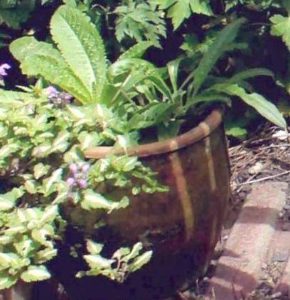
Terracotta pot with Vipers Bugloss & Teasel, both plants in their first year. Vipers Bugloss was planted out.
Here in Highbury
We had Viper’s Bugloss years ago. It was planted in a large terracotta pot with a Teasel. When the teasel had won the struggle for the pot, the Viper’s Bugloss was planted into the ground in a less sunny position.
In year two of the Bugloss’s life, these few photos were taken. However prodigious it was at seed-making, the garden wildlife obviously managed to peck up every one it produced. No self-seeded Viper’s Bugloss plantlets appeared the following season.
One day we hope to grow it here again & provide it with a sunnier position & grittier soil.
Other names: Adderwort, Blue Bottle, Blue Cat’s Tail, Blue Devil, Blue Thistle, Blueweed, Bugloss, Cat’s Tail, European Hawkweed, Ironweed, North American Blueweed, Our Saviour’s Flannel, Paterson’s Curse (Australia), Snake Flower, Viper’s Grass, Viper’s Herb.


